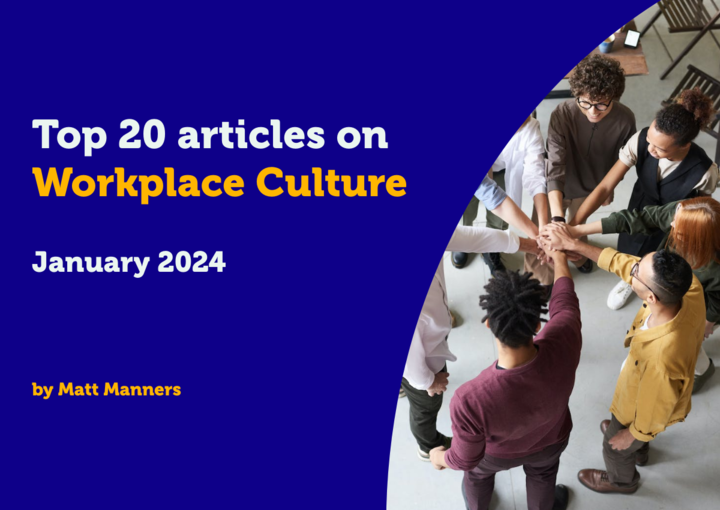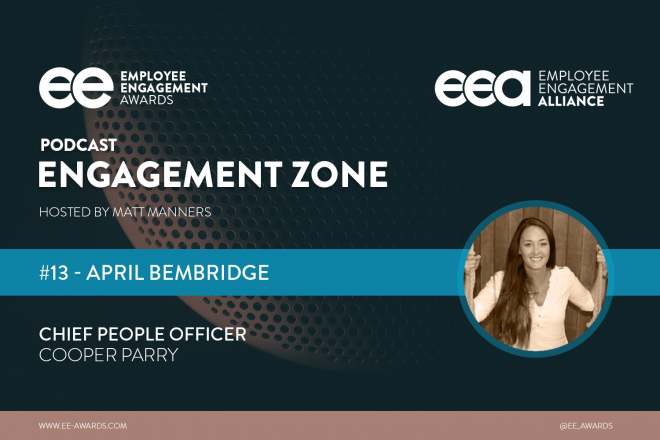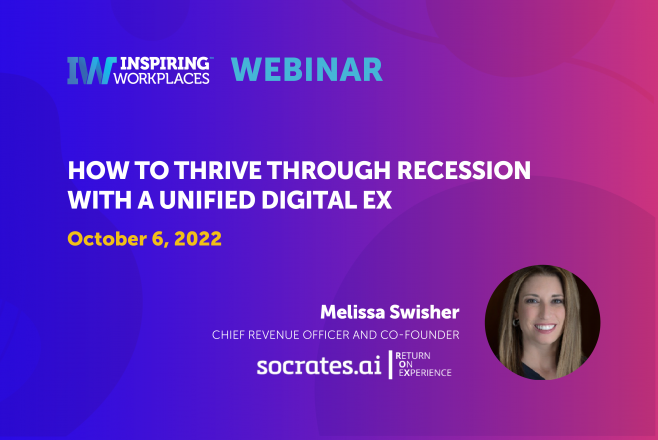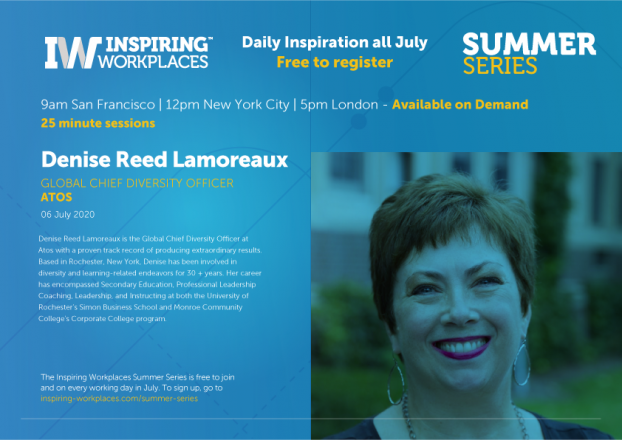
06th February 2024
Top 20 articles on Workplace Culture: January 2024

Welcome to the Inspiring Workplaces Top 20 Articles on Workplace Culture for January 2024.
Before we get into it, we want to remind you that there is just two two weeks until the worldwide entry deadline for Top Inspiring Workplaces – February 21, 2024. Get your entry pack now.
Back to our Top 20 articles. We want to help inform and inspire you from some of the best content out there. Each month we will consolidate these articles for you to help give you a quick and easy snapshot. To help drive you and your organisations forward.
The articles will be underpinned by seven key elements that are reflected in our bespoke COMPASS methodology, that also underpin the Top Inspiring Workplaces worldwide. They are:
- Wellbeing
- Culture & Purpose
- Leadership
- Inclusion
- Employee Experience
- Communication & Voice
- Society & Sustainability
We hope you enjoy and find the below useful.
How To Build A People-First Culture
Source: Forbes
Author: Tom Nolan
COMPASS point: Culture & Purpose
Link to full article here
Key takeaways from the article:
- Kendra Scott, a successful fashion-meets-philanthropy lifestyle brand, places a strong emphasis on values like family, fashion, and philanthropy, with the motto “Connection before transaction.”
- The author emphasizes that people don’t work for companies; they work for people, highlighting the importance of focusing on the human aspect of business.
- Hiring individuals who align with the company’s values and goals is crucial for maintaining and evolving the company’s culture.
- The author shares a personal experience of joining Kendra Scott full-time after witnessing the company’s commitment to philanthropy in action, emphasizing the importance of aligning values with actions.
- To build a people-first culture, companies need to provide benefits that support their team’s personal and professional development, offer reasonable work-from-home options, flexible work hours, and consider floating discretionary holidays.
- Putting the community first and engaging in philanthropic actions as part of the company’s work can help build trust and strengthen the organization’s foundation.
- A people-first philosophy and culture set a company apart from competitors, fostering unique loyalty through empathy and philanthropy, both externally with customers and internally with the workforce.
- The article concludes that values should be at the core of a people-first culture, and a company’s entire business should be built upon those values, recognizing that employees are the company’s greatest asset.
A new sense of ambition: Workers voice interest in work-life balance, belonging over climbing the corporate ladder
Source: HR Dive
Author: Carolyn Crist
COMPASS point: Employee Experience
Link to full article here
Key takeaways from the article:
- According to Randstad’s Workmonitor report, 56% of workers worldwide consider themselves ambitious, but 47% are not primarily focused on career progression or climbing the corporate ladder.
- The report highlights a shift in ambition towards work-life balance, flexibility, equity, belonging, and upskilling.
- Workers prioritize factors like work-life balance, schedule flexibility, mental health support, and training opportunities over traditional career ambition. However, despite these priorities, workers are less confident about leaving their jobs if their expectations aren’t met, possibly due to increased concerns about job security.
- Employers are urged to communicate with their talent to understand their individual motivations and priorities.
Blue month: Make Employee Experience A Focus In The Dreary Midwinter
Source: Minute Hack
Author: Staff writer
COMPASS point: Employee Experience
Link to full article here
Key takeaways from the article:
- As the mid-winter blues set in, employers are encouraged to prioritize their employees’ well-being and productivity.
- The post-holiday period can be challenging, leading to dissatisfaction and even quitting for many workers.
- To combat this, companies should focus on improving the overall employee experience. Addressing issues such as workload management, digital transformation, and digital collaboration tools can reduce stress and burnout, enhancing job satisfaction.
- Moreover, businesses should embrace digital-first approaches to enhance stability and customer satisfaction. By integrating CRM solutions and automation, companies can streamline operations, improve market intelligence, and provide personalized customer interactions, ultimately creating a more positive and productive work environment throughout the year.
Belonging Is A Top 2024 Workforce Strategy, Not RTO
Source: Forbes
Author: Jan Bruce
COMPASS point: Culture & Purpose
Link to full article here
Key takeaways from the article:
- In 2024, workplace success hinges on cultivating a sense of belonging among employees, transcending the debate of where work occurs.
- Research shows that fostering belonging drives organizational performance, enhances job performance, reduces turnover risk, and boosts employer net promoter scores.
- Workplace loneliness due to a lack of belonging costs companies billions annually.
- To build belonging at work, leaders must address psychological risks, train managers in resilience skills, and connect employee work to the company’s purpose and mission, ultimately driving engagement and productivity in the turbulent year ahead.
Workplace health benefits don’t move the needle on improving employee happiness and well-being. With one exception
Source: Fortune
Author: Alexa Mikhail
COMPASS point: Wellbeing
Link to full article here
Key takeaways from the article:
- A recent study from the UK suggests that workplace mental health benefits, including virtual therapy and mindfulness programs, often fail to improve employee well-being significantly.
- Analyzing data from over 46,000 workers across 230 companies, the study found that most interventions did not positively impact employee well-being, except for volunteering, which had a positive correlation.
- Experts argue that standard well-being programs may be too simplistic, and more intentional innovation is needed to address the complexities of workplace culture and employee stressors.
- Workers prioritize structural changes such as limiting work outside of typical hours and implementing a 4-day workweek as key well-being policies.
- Building a mentally healthy workplace requires innovative care models tailored to individual and workplace needs.
5 Easy Ways to Recharge Your Corporate Diversity, Equity, Inclusion, and Belonging Efforts for 2024
Source: Inc. Magazine
Author: Michelle Siverthorn
COMPASS point: Inclusion
Link to full article here
Key takeaways from the article:
- In 2024, after a challenging 2023 for diversity, equity, inclusion, and belonging efforts, it’s crucial to recharge and stay ahead. To do so, Michelle Silverthorn suggests five strategies.
- Firstly, assess current DEIB initiatives’ effectiveness and adapt as needed.
- Secondly, establish DEIB committees with diverse employee representation to foster improvements.
- Thirdly, cultivate an inclusive culture by celebrating differences and enhancing accommodations.
- Fourthly, hold leadership accountable for DEIB progress.
- Lastly, provide practical DEIB training and education for all employees, aiming for real, lasting change in workplace diversity and inclusion. It’s an ongoing effort to make diversity matter for good.
3 Leadership Priorities Shaping Talent Development in 2024
Source: Association for Talent Development
Author: Stephanie Neal
COMPASS point: Leadership
Link to full article here
Key takeaways from the article:
- In 2024, companies must prioritize leadership development in three key areas to thrive in the changing workplace landscape.
- First, leaders should help employees embrace AI by fostering trust, transparency, and ethical accountability in technology adoption.
- Second, leaders need to be prepared to manage hybrid teams effectively, emphasizing relationship-building, emotional intelligence, and open communication.
- Finally, organizations must ulfil their diversity, equity, and inclusion (DEI) promises by equipping leaders with critical skills like empathy, communication, delegation, feedback, and conflict resolution to create an inclusive workplace culture.
- Strategic leadership development is essential for organizations to navigate and succeed in 2024.
Seven ways to build open communication into your workplace culture
Source: People Management
Author: Frank Devine
COMPASS point: Communication
Link to full article here
Key takeaways from the article:
- In a recent article, Frank Devine discusses the importance of open communication in the workplace culture and offers seven ways to achieve it.
- He emphasizes the need to create curiosity and trust among employees, encouraging leaders to surprise and exceed expectations.
- Devine also suggests aligning engagement strategies with ambitious goals, maximizing employees’ decision-making autonomy, and supporting engagement with proper enablement.
- Peer-to-peer communication at all levels and embracing cultural diversity are recommended, along with reframing challenge and feedback as drivers of improvement rather than negative interactions.
- Building psychological safety for employees to express their opinions is essential for a healthy workplace culture.
Unlearning Silence in the Workplace: How to Speak Up at Work
Source: Success
Author: Elaine Lin Hering
COMPASS point: Employee Voice
Link to full article here
Key takeaways from the article:
- The article discusses the importance of breaking the silence in the workplace and offers insights on how to speak up effectively.
- Harvard Law School lecturer Elaine Lin Hering explores this concept in her upcoming book, “Unlearning Silence,” emphasizing the need to unleash talent, express thoughts, and be authentic.
- Workplace experts emphasize the significance of open communication, inclusivity, and constructive feedback to create a positive work culture.
- The article highlights that unlearning silence can have a more significant impact on women, addressing challenges related to historical gender norms.
- It also provides tips on how to approach sensitive topics and suggests coming up with solutions when voicing concerns.
- Additionally, the article outlines steps to unlearning silence and how companies can foster open conversations among employees. Ultimately, promoting honest communication contributes to improved workplace culture, innovation, and employee satisfaction.
Any good DEI strategy has this one thing
Source: Fast Company
Author: Kellie Walenciak
COMPASS point: Inclusion
Link to full article here
Key takeaways from the article:
- In the pursuit of diversity, equity, and inclusion (DEI) success in corporations, collaborative leadership involving the Chief Marketing Officer (CMO), HR leaders, and the Chief Diversity Officer (CDO) is essential.
- These three roles form a triad that weaves DEI into the corporate narrative effectively, ensuring authenticity and impact.
- A collaborative approach transcends traditional boundaries and silos, addressing DEI across all aspects of the organization.
- The CMO shapes brand messaging and values, HR builds an inclusive workplace culture, and the CDO oversees DEI strategies and accountability.
- Collaboration leads to a richer, more innovative workplace, where diversity is integrated into the company’s DNA, benefiting both internal and external stakeholders.
- This approach involves integrated strategies, unified communication, goal alignment, data-driven decisions, and public commitments, ultimately fostering a workplace where diversity is valued, equity is pursued, and inclusion is experienced by all.
New study finds AI makes employers value soft skills more
Source: Fast Company
Author: Peter Cardon
COMPASS point: Communication
Link to full article here
Key takeaways from the article:
- In the age of AI integration into workplaces, a study by business school professor Peter Cardon reveals a shift towards valuing soft skills that enhance human interactions and enrich company cultures.
- Employers anticipate that AI will be most effective when it complements human talents and fosters human connectedness.
- The research highlights the growing importance of ethics and interpersonal communication skills, with integrity being the top-rated quality.
- To maintain trust and authenticity, organizations should openly address AI’s ethical implications and engage in collaborative discussions.
- Additionally, while AI may handle written communication, oral communication skills are predicted to become more crucial for demonstrating compassion, creativity, and vision.
- Prioritizing human-centered soft skills can lead to more vibrant, innovative, and connected workplaces in the AI era.
Too few leaders factor sustainability into business decisions, HR professionals say
Source: HR Grapevine
Author: Staff writer
COMPASS point: Society & Sustainability
Link to full article here
Key takeaways from the article:
- A survey of nearly 100 HR professionals conducted by HR recruitment firm Wade Macdonald indicates that 43% of business leaders do not incorporate sustainability into their business decisions.
- While sustainability influences internal workplace policies, it is rarely extended externally.
- The survey also highlights a lack of priority for sustainability among HR professionals. Corporate Social Responsibility (CSR) is considered essential by the CIPD, but financial and legal incentives for leaders to make sustainable decisions are lacking.
- While 80% of respondents reported internal sustainability policies, external sustainable initiatives, such as business partnerships, remain less common.
- Most believe sustainability is a joint responsibility between employees and employers.
- As green jobs and sustainability gain importance, HR roles are expected to evolve to incorporate more green hiring, training, and compensation.
Gaps widen in latest workplace happiness index
Source: Relocate Global
Author: Ruth Holmes
COMPASS point: Wellbeing
Link to full article here
Key takeaways from the article:
- A global study of 300,000 individuals in Australia, New Zealand, Ireland, the US, and the UK for 2023 reveals workplace trends and concerns.
- Generation Z, impacted by the pandemic, sees declining engagement and increasing “fight risk.” Concerns over pay and a gap between employee expectations and what employers can offer are prevalent.
- Employers are introducing mentoring to bridge skills gaps. Inclusive cultures and practices are vital for employee motivation.
- Different countries have unique challenges: the UK lags in engagement and faces a high flight risk for disabled employees, while the USA outperforms in engagement. Ireland and Australia have their own inclusion challenges, and New Zealand shows high job satisfaction.
- Gender and disability gaps persist, highlighting the need for better support.
How to apply ‘3D Leadership’ in your work
Source: PR Daily
Author: Mary Olson-Menzel
COMPASS point: Leadership
Link to full article here
Key takeaways from the article:
- In the world of innovative and transformative leadership, individuals like Steve Jobs have left an indelible mark by embodying “3D Leadership,” which entails defining reality, declaring intention, and deciding strategy.
- This concept, developed by Dr. Mark Goulston, highlights how exceptional leaders envision a better future, challenge the status quo, and inspire collective efforts to achieve their visionary goals.
- They don’t just predict the future; they create it. To become a 3D leader, one must cultivate curiosity, embrace the unknown, and follow the “Whoa, Wow, Hmm, Yes” sequence, ultimately laying the foundation for innovative thinking and transformative leadership.
- This mindset empowers leaders to shape the future and make a meaningful impact on their organizations.
Hiring for Cultural Fit? Here’s What to Look For
Source: Business News Daily
Author: Skye Schooley
COMPASS point: Culture & Purpose
Link to full article here
Key takeaways from the article:
- Cultural fit in the workplace is crucial for employee satisfaction and retention.
- It involves aligning employees’ beliefs and behaviors with a company’s core values and culture.
- A survey revealed that 77% of job seekers consider a company’s culture before applying, emphasizing its importance.
- To hire for cultural fit, companies should define their culture, convey it in hiring materials, train staff to discuss it genuinely, offer candidates an immersive look, and factor in diversity, equity, and inclusion.
- Prioritizing cultural fit enhances job satisfaction, engagement, and retention, ultimately leading to a more harmonious and productive work environment.
Improve Work Performance With a Focus on Employee Development
Source: Gallup
Author: Rob Desimone
COMPASS point: Employee Experience
Link to full article here
Key takeaways from the article:
- Creating a high-performance workplace involves instilling a high-development culture that values individual growth.
- Organizations investing in employee development report 11% higher profitability and higher retention rates.
- Four key strategies set such workplaces apart:
- 1) Ensuring employee engagement to prevent talent loss,
- 2) Recognizing that development doesn’t always mean promotion but aligning employees’ strengths with their roles,
- 3) Managers acting as coaches for individual development,
- 4) Leadership commitment to a culture of high performance. Such a focus on development not only retains top talent but attracts more, ultimately benefiting the company’s growth and future.
3 Ways to Embed DEI Into Your Company’s AI Strategy
Source: Harvard Business Review
Author: Andy Baldwin
COMPASS point: Inclusion
Link to full article here
Key takeaways from the article:
- In an article discussing the integration of diversity, equity, and inclusion (DEI) into AI strategies for companies, the author emphasizes the importance of ensuring that artificial intelligence does not exacerbate existing inequalities.
- To achieve this, businesses should embed DEI principles into the design of AI systems, involving diverse stakeholders and training the AI on inclusive data.
- Additionally, upskilling programs should prioritize DEI, enabling underrepresented groups to benefit from AI opportunities.
- Ethical AI can also identify and rectify disparities, such as pay gaps, while enhancing workplace accessibility for people with disabilities.
- Ultimately, a people-centered AI transformation is essential for long-term growth and success.
What We Want From Work Is Changing — For The Better
Source: Forbes
Author: Lindsay Kohler
COMPASS point: Culture & Purpose
Link to full article here
Key takeaways from the article:
- Purpose Matters: Approximately 82% of employees believe that having a sense of purpose in their work is crucial. Purpose at work is seen as significant due to the impact it brings.
- Changing Expectations: The past year has seen a rise in employee disengagement, which could cost the economy trillions. This disengagement is attributed to changing expectations in the workforce, driven by reflection on the value of time and a desire for more meaningful work.
- Positive vs. Negative Sentiment: Employees are increasingly focused on whether their jobs and workplaces align with their values and contribute positively to their lives. Toxic work environments and jobs that prevent life enjoyment are reasons why employees may leave.
- Leadership and Purpose: Leaders can reverse negative sentiment by providing a sense of belonging and addressing work-life balance and toxic culture issues. Understanding and embracing a shared sense of purpose can unite employees and organizations.
- Stating Purpose: Defining and articulating purpose is crucial. Organizations should reflect on why they started their work in the first place, which can help clarify their “why.”
- Individual Purpose: People are now looking for meaning and purpose beyond standard job attributes. Companies can help employees discover their individual purpose and how it aligns with their roles.
- Assessment and Onboarding: Incorporating purpose assessment tools into the onboarding process can help employees identify their purpose and share it with their teams, enhancing collaboration and alignment.
- Purpose as an Ethos: Purpose is not just a program; it’s an organizational ethos. It’s about understanding the impact of one’s actions and how they contribute to a larger goal.
In summary, the article emphasizes the increasing importance of purpose at work, the need for organizations to define and embrace their purpose, and the significance of helping individuals discover their own purpose within their roles.





